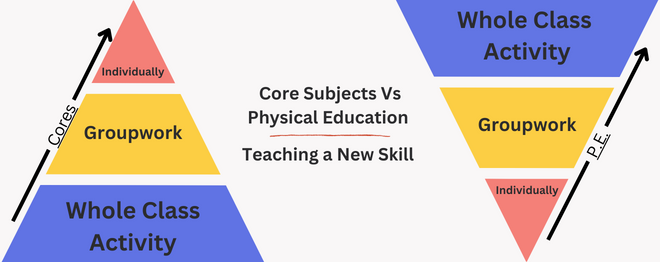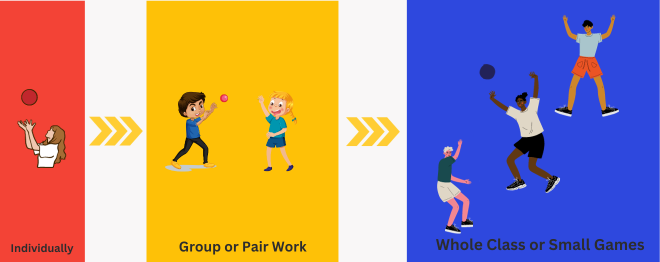How Teaching Physical Education Differs from Other Subjects

In the world of education, the teaching methods used in physical education often differ significantly from those used in core subjects such as mathematics or English. In the cores we typically follow a progression model of whole-class instruction, to group activities and finally to individual tasks.
When it comes to physical education we flip this model on it's head and adopt a reverse approach - students usually start by practicing skills alone, then move on to working together, and finally play challenging games as a whole class.
This method helps them get the hang of the skill step by step and move them towards mastering the skill and using it under pressure in a game situation.

Piggy In The Middle
Let's take the example of a classic game like "Piggy in the Middle" to illustrate this. In this game, the objective is for a group of students to throw and catch a ball while a designated "piggy" attempts to intercept the ball as it is passed between players.
1. Individual Skill Practice:
Initially, students begin by practicing the fundamental skills of throwing and catching the ball independently. This phase focuses on developing each student's competence and confidence in executing these skills. For instance, students might practice throwing the ball against a wall and catching it to improve their accuracy and coordination.
2. Pair or Small Group Activities:
Following individual practice, students then work in pairs or small groups. Here, they apply their acquired skills in a more interactive setting by throwing and catching the ball with a partner or in groups of three. This stage fosters cooperation and communication among peers while refining their ability to control the ball.
3. Pressurized Situation – Piggy in the Middle:
Finally, the progression leads to applying these skills in a pressurized environment such as playing "Piggy in the Middle." In this game scenario, there's a heightened level of challenge introduced as one student, the "piggy," attempts to intercept the ball. This added pressure demands greater accuracy, timing, and problem solving skills from the students as they try to catch, throw and keep possession of the ball with the heightened challenge.

By putting the skill into practice in a game-like situation, students in not only improve their technical skills but also develop strategic thinking, teamwork, and problem-solving skills.
Compare that to math or English, where it's usually teacher-led, group work, and then individual tasks. Both ways aim for skill mastery, but the P.E. lessons path—starting with individual practice and ending up in a game-like scenario—teaches us teamwork, quick thinking, and handling pressure. These skills, are not just for the P.E. class; they're life skills, wouldn't you agree?
Curious to see this methodology in action? Sign up for a free trial on our website today! Get an exclusive sneak peek into our interactive platform that incorporates these engaging methods into fun and beneficial physical education lessons. It’s a chance to witness how we transform individual skill practice into exciting group activities, culminating in game-like scenarios that boost confidence and teamwork.
